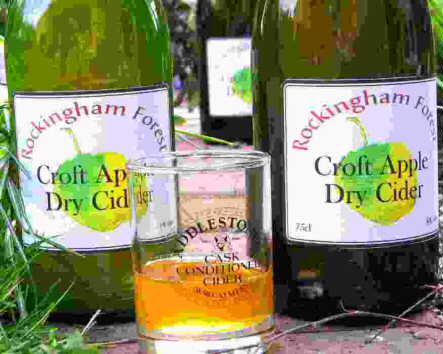
Croft Cider?
Some years ago I asked on this website if anyone could
identify an apple growing near Croft in Leicestershire.
No-one gave a convincing answer, so we took some to an expert
at Ryton who said it was a bittersharp cider apple
The next year we
took some to Brogdale, and had a close look at their cider
apple exhibition. The closest (rather poor) match we could find
was the variety "Fair Maid of Taunton".
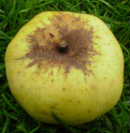
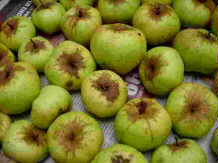
There's a link about this, and more pictures, on the main Apples page.
I was interested to be contacted in 2005 by a cider enthusiast and
maker, Mark Shirley, of Rockinghan Forest Cider, who said he was
prepared to do a test pressing of 80lb or so of the apples, and to see
what kind of cider resulted.
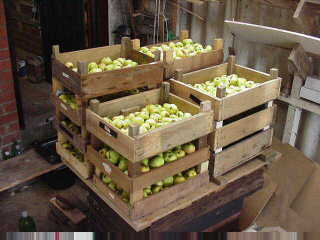
It was quite tricky picking as many as this; the tree isn't
very accessible, but eventually
we had enough, and Mark has now collected them. Pressing should be done
in September. I'm told that it's unlikely a single variety like
this will make a good cider on its own, but it might be useful
for blending, and a cider apple from Leicestershire is quite
unusual.
For those who are interested, it's high in malic acid, very
sharp, texture just about eatable, yellow, ribbed and
quite highly scented. It's generally ready in Sept-October but this year
is a month early.
If you want to investigate Mark's site, he can be found at
http://rockinghamforestcider.moonfruit.com/
His company Rockingham Forest Cider is on the Northamptonshire / Leicestershire
border, in Middleton.
N.D., Sept 2006
UPDATE, 15 Sept
Initial findings:
We left the apples for around two weeks in the hope that these apples would behave in a similar way to cider varieties, and continue to convert starch to fermentable sugars during extended storage. During this time we lost a handfull to rot (interstingly, the apples went black and were still firm, rather than the usual soft Brown Rot with obvious fungal growth).
We gave the apples a wash in clean water, and milled the fruit with a centrifugal mill. We found these apples did not mill to as fine a texture as cider and culinary/dessert fruit we have milled in the past. Indeed the 'pomace' was quite dry and produced no free-run juice during the building of the 'cheese'. Usually some juice will be produced during the milling process, and will start to flow during the building of the first or second layer of the cheese.
We conducted two pressings of this fruit, and managed to collect 15 litres of juice. This is quite a low yield, and we were concerned that perhaps the milling process was at fault. However, a later pressing of an unknown dessert variety behaved in exactly the way we would have expected, with almost as much juice expressed from half the quantity of apples.
The juice oxidised quite heavily, suggestive of a reasonable tannin content. The original gravity as determined by hydrometer was a surprisingly high 1058 (see pic). This gives a potential alcahol level of around 7.8% if fermented to dryness.
The pH was measured with Vinoferm pH strips, and found to be approx 3.1 (see pic)
An acid titration was conducted which gave an acid level of 1.55% Malic
Since the pH is low (high acid), no Sulphur was added and the juice was innoculated with a cultured wine yeast.
Initial conclusions:
The high sugar levels of the juice were quite a surprise, and may have been helped by the extended storage. It would be interesting to compare the juice from freshly picked apples and those which have been stored.
The biggest disappointment was the juice yield. It's possible that this was also affected by the extended storage. Sadly, any otherwise positive atributes of this apple for cidermaking, could be seriously compromised by the poor juice extraction.
The pH of the juice should contribute to a clean fermentation, but the very high Malic acid content (most important to perceived acidity in the finished cider), would certainly make this a difficult apple to make a single varietal cider from, but may have value in a blend, particularly if the aromatic and possible tannic qualities are evident following fermentation. As a comparisson, Bramley Seedling has been found to have a Malic acid level of 0.85%, and most Sharp cider fruit are in the region of 0.60 - 0.70%. Having said that, the highly regarded Gloucestershire bittersharp cider apple Broxwood Foxwhelp has been measured as having 1.90% Malic!
I'll let you know how the fermentation is progressing, hopefully not too vigorously in this warm weather.
Mark Shirley
PICTURES:
Croft cider apples
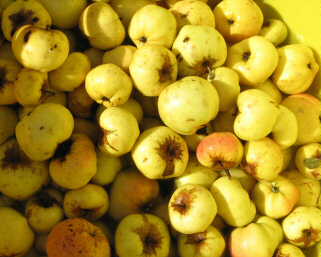
More of them...

Filling the press
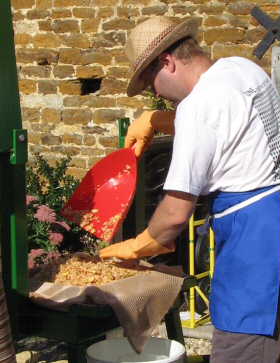
Pressing
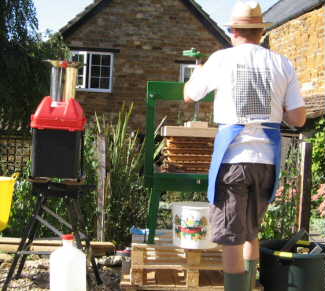
Pressed
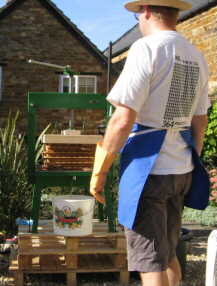
Apple juice density

Apple Juice pH test
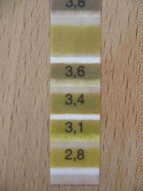
Sept 23
The other apples I pressed last weekend (possibly Spartan)had a modest original gravity of 1042, yet they are fermenting rapidly. The Croft Apple cider was slower to start and the fermentation has been sluggish. I decided that it would be better to rack off and get this cider under airlock sooner rather than later. The CO2 blanket produced in the initial, vigorous phase of fermentation is usually adequate to protect the juice from any possible infection or excessive oxidisation, but in the case of the Croft Apple I was concerned that the level of yeast activity was not sufficient to guarentee this.
The cider is now safely under airlock, but the rate of fermentation is a fraction of what I would expect at this stage. I'm guessing that this may be due to the very low level of nutrients available to the yeast, a situation common with old trees which have never had the benefit of a natural or agricultural fertilizer.
I have decided not to add a yeast nutrient, since a slow fermentation of a low natural nutrient juice may result in a better cider, but I'll have to keep a close watch on things and take action if the fermentation grinds to a halt.
On a positive note, the juice pressed with very little cloudiness, and the cider has a lovely golden colour at the moment (see pic).
Juice fermenting
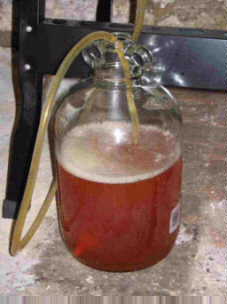
Sept 24
I was perhaps a little premature regarding the fermentation, all three
demijohns are now fizzing away quite happily now, perhaps the slight
aeration during racking off has given the yeast a boost.
25 Mar 07
I bottled the Croft Apple cider today and enclose a picture (shown below). This is my notes from tasting the finished (?) cider. It was still producing CO2 at a very slow rate, but since this was a relatively early cider, I felt it was probably as good as it was going to be.
The colour is a fairly deep golden and slightly hazy. The aroma is fruity with perhaps a hint of toffee apples!
The flavour is fresh and sharp, the tannin is expressed as a mouth-drying astringency with little discernable 'bittersweet' character. There is no hint of oxidisation or acetic (vinegar) taint. The basic flavour is pleasant, but the astringency is too dominant, and balance too sharp.
When sweetened with sugar to a medium sweetness, the sharpness becomes more balanced, but the astringency is still too pronounced.
When further sugar is added to give a sweet cider, a fresh apple flavour becomes apparent, and the cider is altogether more balanced with a greater depth of tannin character, although the astringency still dominates.
Mark Shirley
The finished "Croft Cider"
